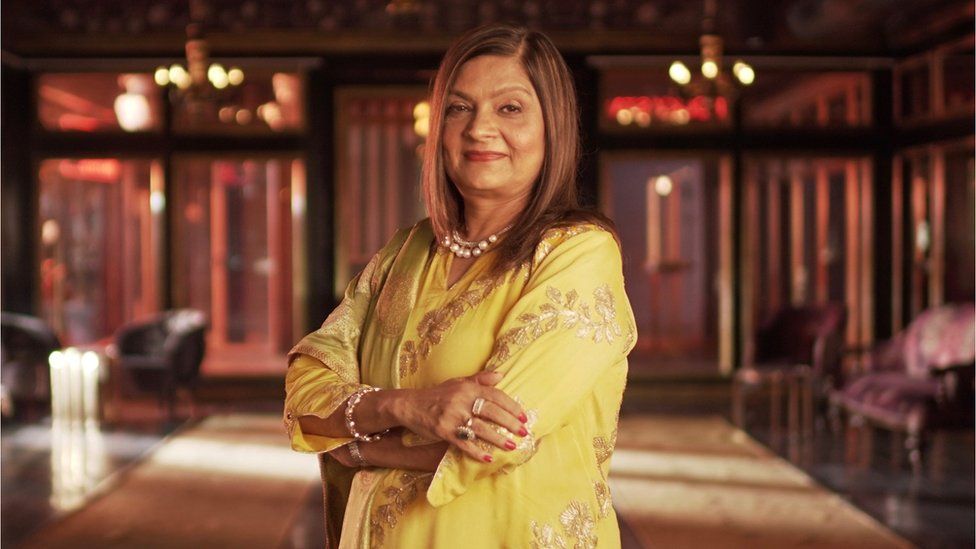It’s very likely that we’ve all at least scrolled past the show Indian Matchmaking while browsing Netflix. Now, usually I am not a fan of dating shows. But Indian Matchmaking is based around South Asian couples so I was intrigued, as this area has gone largely unexplored or been poorly handled with shows such as Karan Johar’s What the Love! (which is also available to watch on Netflix and is so cringey, I couldn’t watch past the second episode). I sat through the whole two seasons of Indian Matchmaking which is more than I can say for any other show.
Sima Aunty
The show alternates between India and America and focuses on extremely well off South Asian adults, all actively searching for marriage partners. I would say that the main character is the matchmaker herself, Sima Taparia – mostly referred to as ‘Sima Aunty’ by her clients – but she is not anybody’s favourite.
Sima Aunty seems to be that typical, annoying aunty that everybody has who brings her big nose into your house, asks incredibly personal and private questions and judges you for everything you do and think. She also places herself on quite a high horse and thinks she knows exactly what’s best for everyone. She is somehow a top matchmaker and has quite a bit of success in matching couples, which is why people are willing to pay what I assume must be a hefty amount for her services; one of the many annoying parts of the show is that they never do tell us how much Sima Aunty charges.
The show goes on for eight 30 to 40-minute episodes per season, following a few different clients at a time and showing us how Sima Aunty works. She provides a very personal service, starting off with visiting her clients in their homes and finding out what they are looking for, she then goes away and looks through her database to find someone who meets most of her clients’ demands. Something she says to every client is that compromise and adjustment are important and you can’t have everything. She does in fact quote 60 to 70% every now and then as an idea of what her clients should expect. While I agree that compromise and adjustment are essential for any relationship, Sima Aunty seems to mean this in a not so progressive or equal sense.
Why is Aparna the villain?
While the show gives us loveable characters such as Nadia and Vyasar who are down to earth and just overall good people, it places them and their ‘pure goodness’ in contrasts with other characters to highlight ‘negative’ aspects of their personalities. A lot of Sima Aunty’s female clientele appear to be independent and strong women, promoting the already widely agreed but wrong assumption that career women do not make desirable spouses. The show implies numerous times that, if you’re a woman, holding opinions and knowing what you want makes you an unlikeable person who cannot find a partner, whereas the reality is that even in today’s ‘progressive society’ South Asian men still suffer from immense insecurity and self-esteem and do not know how to accept women having their own minds and needs; nobody needs that kind of person as a life partner.
The show uses Sima Aunty to make one of the strong female clients, Aparna Shewakramani, appear as a villain. Aparna simply knows her own mind and has a set of views around what she wants out of her life and partner, and Sima Aunty gets frustrated when it doesn’t work out between her and a few matches that Sima Aunty has provided. She blames Aparna for being picky, negative, unaccommodating and judgemental when the truth is, it is not easy to find a partner that is suited to you and while for some getting along with others is easy as breathing, this is not the case for everybody, and it is unfair to portray that in a negative light.
Aparna says herself that she did not have a positive experience on Indian Matchmaking and is very vocal about the whole thing especially on her TikTok. However, she has not let it bring her down. In fact, she has gone on to write a book and ensured that her side of her story is heard. She has tons of supporters and her book is incredibly relatable, selling very well with 4.6 stars on Amazon. By villainising a progressive and ambitious woman, the show promotes the idea that women need to be submissive and compliant to be liked.
The male characters
Another client who Sima has a hard time with is a wealthy, over-the-top glam guy called Prahdyuman and a spoilt mama’s boy called Akshay. Both are annoying in their own way. Pradhyuman is shown to be incredibly superficial saying no to hundreds of girls after a quick glance at their pictures. He somehow still gets his happy ending though, with…yeah, a model/actress.
You can somewhat forgive Pradhyuman’s nature and sort of be happy for him, but Akshay is just a whole other story; saying that, I do believe it is his mother that plays the biggest role in nobody liking him. In his mother we see what is a very realistic depiction of upper-class South Asians. With a huge list of what her son’s wife should be like, including but not limited to tall, light-skinned, educated but traditional and from a ‘good family’, Sima Aunty simply nods in agreement and goes off to find a match for this crazy woman. She has a wealthy husband and two sons; one is married and now it’s the other’s turn. He has no say in the when of the wedding, only in the who, but even these are heavily filtered to meet the mother’s requirements.
At one point, Akshay’s mum says to him that he must decide and choose fast and be married in a year because his brother has to then start a family. Akshay’s mum is very involved in her children’s personal lives, and it is very icky. Another awkward and disturbing statement from this family is Akshay saying he wants to be married to someone just like his mother (Freud is probably doing his ‘I told you so’ dance in his grave).
The show does little to challenge the underlying problems
Around the world South Asians have been intrigued and offended by the show, with concerns raised about the requirements of caste and colour and the generally regressive nature of arranged marriages. Sima Aunty says, “In India, we don’t say ‘arranged marriage’ — there’s marriage and then love marriage.” And her tone and words clearly show that she thinks this is fine and something that should just be expected and accepted. Similarly, she asks her clients about what they want in a partner and while she does call out clients when they make too many demands, she is accepting and accommodating of caste and colour saying that a ‘good family’ is important to a lot of people; an obvious reference to the Indian caste hierarchy. She also says of a client “looks-wise, she’s OK, but she’s not photogenic” – the show constantly highlights the ideas that people, especially women, who are dark-skinned, short, overweight etc. are a lost cause and extremely difficult to match. Sima Aunty constantly points her finger at her clients and what’s wrong with them when the real problem is the ideologies and societal views.
The truly devastating part of watching Indian Matchmaking is that after you watch it, you love and hate the clients, and you detest all the bad things about it, you will at some point sit and come to a crushing realisation that the show was not wrong. The show although not without flaws, tells it like it is. The characters are all very real, the types of people on the show actually exist in the real world and, scripted or not, these ideologies and practices are still going strong in society. Parents are still very much like Akshay’s irrational mother, and they do still want to stay within their classes and castes. At the same time, the overseas Indians or South Asians also have that deep rooted need to marry someone from a similar background. Be they immigrants, first generation or second, a lot of them are brought up in a way that makes them feel like a partner should be from the same background and they can have their own reasons for this but the fact that they feel this way speaks volumes about just how deeply imbedded some things can be. The show does not critique or question anything and this is where the problem lies.
By glamorising and speaking about these traditions in such a nonchalant manner, the show might as well say this is all fine and that they do agree with everything being said. Martin Luther King once said, ‘to ignore evil is to become an accomplice to it’ and Ginetta Sagan once wrote, ‘silence in the face of injustice is complicity with the oppressor’.












